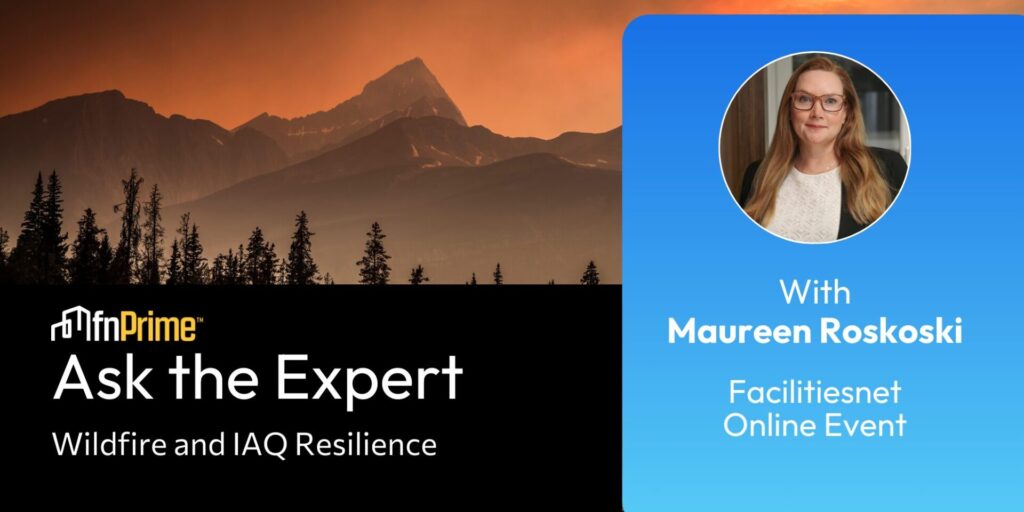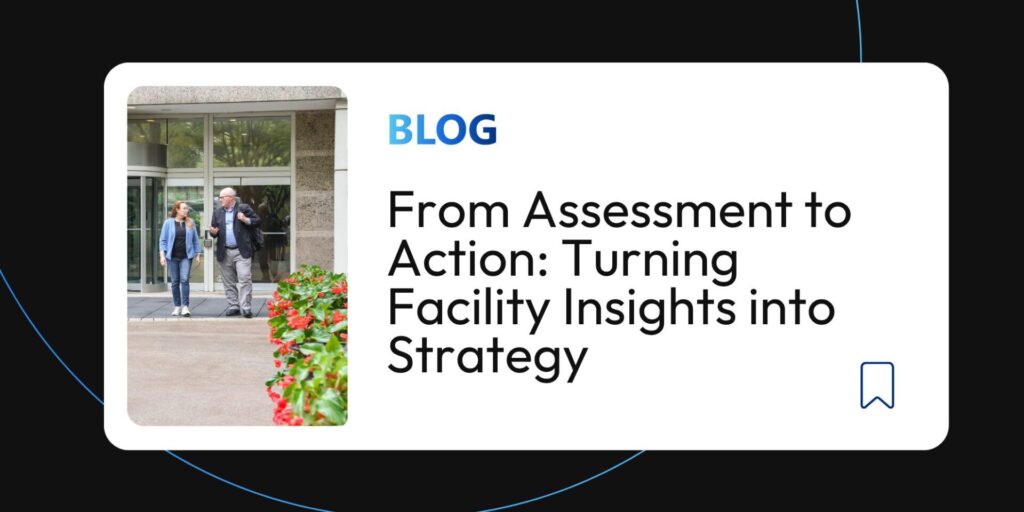Did you know that as of 2024, there have already been 36,398 wildfires burning over 6.9 million acres? And unfortunately, the problem is projected to get worse, with experts predicting a 14% increase in wildfires by 2030 and a 30% rise by 2050. But here’s something many don’t realize—wildfire smoke doesn’t just affect properties in the direct path of flames. It can travel thousands of miles, impacting indoor air quality (IAQ) in facilities far from the source of the fire.
That’s why we’re hosting a critical “Ask the Expert” session on Wildfires and IAQ Resilience. Join us on Wednesday, October 23 at 12 Noon ET to hear from Maureen Roskoski, VP at FEA. Maureen knows firsthand the devastating effects of wildfires, having been in Lahaina, Hawaii, during the tragic Maui wildfire.
Don’t miss this chance to learn how to protect your facilities, strategies for enhancing indoor air quality, ensure safe air quality for your occupants, and plan for the future in a world facing more frequent and intense wildfires.
Why Build Resilience for Your Facilities?
Building resilience in the face of increasing wildfire risks and air quality challenges is critical for the long-term health and safety of both facilities and their occupants. As climate change continues to intensify the frequency and severity of wildfires, it’s essential for government and private sector facilities to proactively address these risks.
By implementing strategies for enhancing indoor air quality (IAQ) and fortifying buildings against environmental threats, organizations can minimize disruptions, safeguard public health, and protect valuable assets.
Resilient facilities are not only better equipped to handle immediate crises, but they are also positioned for long-term operational continuity, ensuring that they remain functional and safe, regardless of external challenges. Investing in resilience today means creating sustainable environments that can weather the challenges of tomorrow.
Strategies for Enhancing Indoor Air Quality
Improving indoor air quality (IAQ) is crucial for the health, safety, and productivity of building occupants. Maureen will share a few strategies to enhance IAQ:
- Increase Ventilation: Proper ventilation helps dilute indoor air pollutants by bringing in fresh outdoor air. Upgrading HVAC systems, using air exchange units, or increasing the frequency of air changes can help reduce the concentration of indoor contaminants.
- Use Air Filtration: Installing high-efficiency particulate air (HEPA) filters or other advanced air filtration systems can capture airborne pollutants such as dust, allergens, smoke, and even viruses. Regular maintenance and replacing filters as needed will maximize their effectiveness.
- Control Humidity Levels: Maintaining indoor humidity levels between 30-50% can reduce the growth of mold, mildew, and dust mites, which can contribute to poor air quality. Dehumidifiers and humidifiers can help regulate moisture levels, especially in areas prone to dampness.
- Reduce Sources of Indoor Pollution: Minimize the use of products that release volatile organic compounds (VOCs) such as certain paints, cleaning products, and synthetic materials. Opt for low-VOC or non-toxic alternatives to improve air quality.
- Improve Maintenance of HVAC Systems: Regular cleaning and maintenance of HVAC systems—such as ducts, filters, and coils—can prevent the accumulation of dust, mold, and other contaminants that can affect indoor air quality.
- Implement Smoke and Odor Control Measures: In areas impacted by wildfire smoke or other external air pollution, the use of air purifiers with activated carbon filters can help reduce odors and harmful particulates inside buildings.
By employing these strategies, building managers can create healthier, more comfortable environments that improve both occupant well-being and overall building performance.
Strategies to Protect Facilities from Wildfires
Protecting facilities from wildfires requires a multi-faceted approach that combines prevention, mitigation, and preparedness. Here are several key strategies to safeguard your building and its occupants:
1. Create Defensible Space Around Buildings
- Clear Vegetation: Create defensible space by clearing dry vegetation, dead leaves, and other combustibles from the vicinity of your facility. Trim trees and shrubs, especially those that are within 30 feet of structures, to reduce the fuel available to wildfires.
- Fire-Resistant Landscaping: Use fire-resistant plants, rocks, and non-combustible materials for landscaping to create fire breaks. Consider using gravel, stone, or concrete in areas where vegetation might be close to buildings.
2. Upgrade Building Materials
- Fire-Resistant Exterior: Use fire-resistant materials, such as non-combustible siding (e.g., stucco, brick, or metal) and fire-resistant roofing materials (e.g., metal or clay tiles), to reduce the risk of a fire spreading to your building.
- Window Protection: Install tempered or dual-pane glass windows and consider shutters or fire-resistant coverings to protect windows from embers. Ensure that vents and openings are screened to prevent embers from entering.
3. Ensure Adequate Fire-Resistant Barriers
- Firebreaks: Build firebreaks—cleared or plowed areas without vegetation or other combustible materials—around your facility. This helps slow or stop the spread of wildfires.
- Fire-Resistant Fencing: Use non-flammable fencing materials around your facility to prevent fire from reaching your building.
4. Improve Fire Suppression Systems
- Sprinkler Systems: Install or upgrade fire sprinkler systems, especially in high-risk areas. Sprinklers can help prevent fires from spreading inside your facility.
- Fire Extinguishers & Hose Reels: Ensure fire extinguishers and hose reels are readily accessible and properly maintained in case of a small fire outbreak. Be sure to train staff on proper fire safety protocols.
5. Maintain Clear and Safe Evacuation Routes
- Emergency Access: Ensure that access roads and pathways remain clear for emergency responders. Remove any obstacles that could prevent fire trucks and personnel from reaching your facility during an evacuation or firefighting operation.
- Evacuation Plan: Develop and communicate a wildfire-specific evacuation plan for staff and occupants. This plan should include multiple evacuation routes and muster points.
6. Install and Maintain Fire Detection Systems
- Smoke Detectors and Alarms: Install smoke detectors throughout the facility to detect fires early. Link these to an automated alert system that notifies both local authorities and facility managers in case of a wildfire threat.
- Emergency Communication Systems: Maintain communication systems that can quickly notify all occupants about potential wildfire dangers, evacuations, or shelter-in-place directives.
7. Monitor Air Quality and Protect Indoor Environments
- Air Filtration Systems: Equip your facility with advanced air filtration systems to prevent smoke and particulate matter from infiltrating indoor spaces. High-efficiency particulate air (HEPA) filters can help keep the air clean during wildfire season.
- Seal Off Unused Spaces: Close doors and windows, seal vents, and block air gaps to limit smoke infiltration in unused areas during wildfire events.
8. Regular Training and Fire Drills
- Staff Training: Regularly train staff on wildfire safety measures, including how to recognize early signs of fire, evacuate safely, and operate fire suppression equipment. Access our tabletop exercise planning checklist here.
- Fire Drills: Conduct periodic fire drills that include evacuation routes, shelter-in-place protocols, and proper use of fire safety equipment. This ensures that everyone is prepared and knows what to do in case of a wildfire.
9. Monitor and Prepare for Wildfire Seasons
- Situational Awareness: Stay informed about wildfire risks in your area by monitoring local fire reports, weather conditions, and air quality advisories. Consider installing an early warning system that alerts you to nearby wildfire activity.
- Emergency Supplies: Prepare emergency supply kits with essentials like flashlights, first aid supplies, masks, and water in case of evacuation or prolonged exposure to hazardous air quality.
By implementing these strategies, facilities can significantly reduce their vulnerability to wildfires, protect assets and occupants, and ensure that they are better prepared to handle the increasing risks posed by climate change and wildfire activity.




